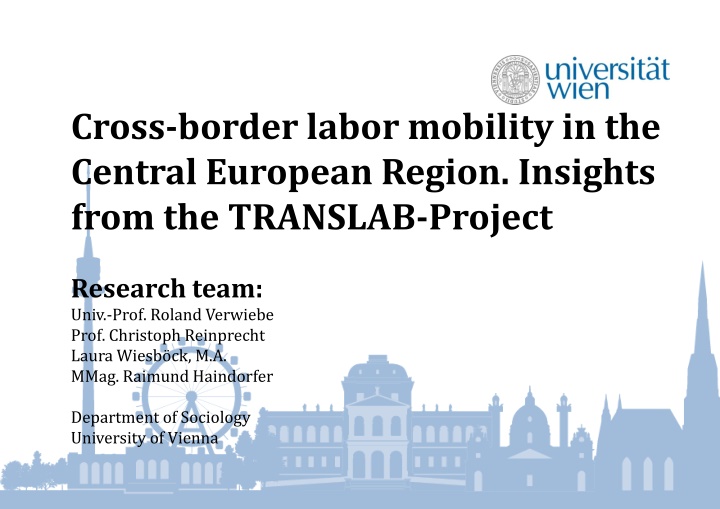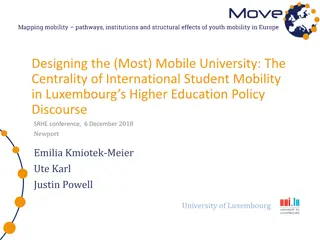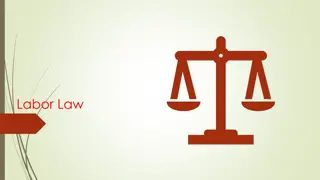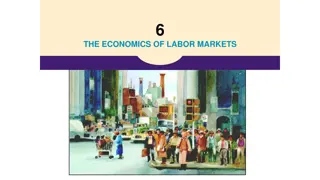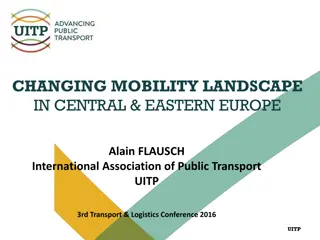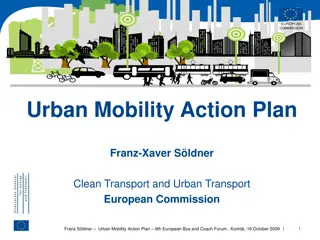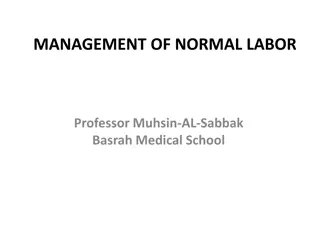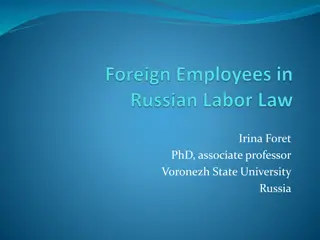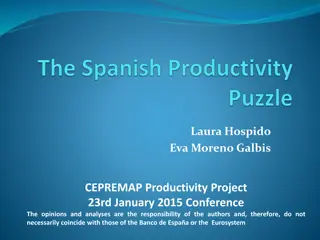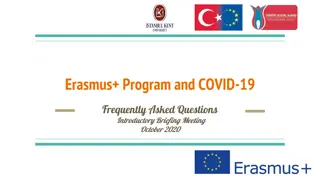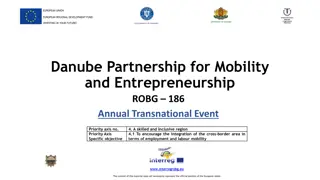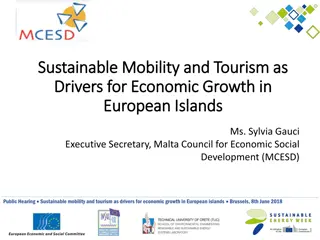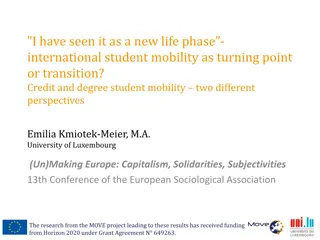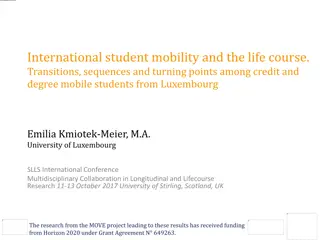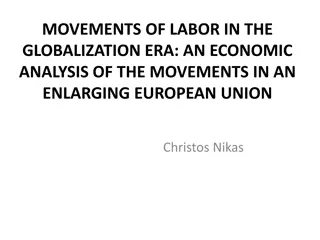Insights into Central European Labor Mobility
Explore cross-border labor mobility in the Central European Region through the lens of the TRANSLAB-Project. Delve into research areas encompassing commuting reasons, wages, job strategies, and more, focusing on Centrope's transnational labor market dynamics amidst historical and political transformations. Uncover the socio-economic factors affecting mobility patterns and societal exchanges across the region.
Download Presentation

Please find below an Image/Link to download the presentation.
The content on the website is provided AS IS for your information and personal use only. It may not be sold, licensed, or shared on other websites without obtaining consent from the author.If you encounter any issues during the download, it is possible that the publisher has removed the file from their server.
You are allowed to download the files provided on this website for personal or commercial use, subject to the condition that they are used lawfully. All files are the property of their respective owners.
The content on the website is provided AS IS for your information and personal use only. It may not be sold, licensed, or shared on other websites without obtaining consent from the author.
E N D
Presentation Transcript
Cross-border labor mobility in the Central European Region. Insights from the TRANSLAB-Project Research team: Univ.-Prof. Roland Verwiebe Prof. Christoph Reinprecht Laura Wiesb ck, M.A. MMag. Raimund Haindorfer Department of Sociology University of Vienna
Research Interest In-depth look at the transnational labor market of the Central European Region (Centrope), where a specific historical political context and European transformations are interfering. Mixed method approach Key research areas: Reasons for cross-border commuting Wages Upward/downward mobility Job finding strategies Life satisfaction Relevance of social networks Working conditions Differences in these research areas regarding gender, age, education, social capital, class 2
The Central European Region (Centrope) ~ 6.5 million people in the eight federal provinces Vienna is the biggest city with 1.8 Mio inhabitants. 3
The Central European Region (Centrope) Several markers of significant changes have led to new interplays of economic, social, political and legal factors: 1991: dissolution of the Soviet Union 2004: EU-enlargement 2011: removal of the last barriers to the free movement of labor Long history of cross-border mobility and social exchange, however: relatively high social inequality between Austrian sub- regions and their neighbors remains to be relevant. 4
Fertiliy rate in Centrope 1990 1.90 1995 1.28 1.28 1.29 1.57 1.55 1.50 1.42 1.25 1.44 1.33 1.52 1.52 2000 1.15 1.16 1.12 1.32 1.24 1.17 1.36 1.19 1.35 1.32 1.44 1.30 1.04 1.13 2005 1.29 1.27 1.27 1.31 1.26 1.21 1.41 1.27 1.46 1.37 1.49 1.27 1.18 1.09 2012 1.45 1.48 1.46 1.34 1.32 1.22 1.44 1.30 1.49 1.40 1.55 1.34 1.42 1.17 Czech Republic Jihoz pad Jihov chod Hungary K z p-Dun nt l Nyugat-Dun nt l Austria Burgenland (AT) Nieder sterreich Wien Ober sterreich Slovakia Bratislavsk kraj Z padn Slovensko 1.87 1.95 1.84 1.46 1.33 1.48 1.39 1.53 2.09
Fertiliy rate in Centrope 1990 1.90 1995 1.28 1.28 1.29 1.57 1.55 1.50 1.42 1.25 1.44 1.33 1.52 1.52 2000 1.15 1.16 1.12 1.32 1.24 1.17 1.36 1.19 1.35 1.32 1.44 1.30 1.04 1.13 2005 1.29 1.27 1.27 1.31 1.26 1.21 1.41 1.27 1.46 1.37 1.49 1.27 1.18 1.09 2012 1.45 1.48 1.46 1.34 1.32 1.22 1.44 1.30 1.49 1.40 1.55 1.34 1.42 1.17 Czech Republic Jihoz pad Jihov chod Hungary K z p-Dun nt l Nyugat-Dun nt l Austria Burgenland (AT) Nieder sterreich Wien Ober sterreich Slovakia Bratislavsk kraj Z padn Slovensko 1.87 1.95 1.84 1.46 1.33 1.48 1.39 1.53 2.09
Fertiliy rate in Centrope 1990 1.90 1995 1.28 1.28 1.29 1.57 1.55 1.50 1.42 1.25 1.44 1.33 1.52 1.52 2000 1.15 1.16 1.12 1.32 1.24 1.17 1.36 1.19 1.35 1.32 1.44 1.30 1.04 1.13 2005 1.29 1.27 1.27 1.31 1.26 1.21 1.41 1.27 1.46 1.37 1.49 1.27 1.18 1.09 2012 1.45 1.48 1.46 1.34 1.32 1.22 1.44 1.30 1.49 1.40 1.55 1.34 1.42 1.17 Czech Republic Jihoz pad Jihov chod Hungary K z p-Dun nt l Nyugat-Dun nt l Austria Burgenland (AT) Nieder sterreich Wien Ober sterreich Slovakia Bratislavsk kraj Z padn Slovensko 1.87 1.95 1.84 1.46 1.33 1.48 1.39 1.53 2.09
Fertiliy rate in Centrope 1990 1.90 1995 1.28 1.28 1.29 1.57 1.55 1.50 1.42 1.25 1.44 1.33 1.52 1.52 2000 1.15 1.16 1.12 1.32 1.24 1.17 1.36 1.19 1.35 1.32 1.44 1.30 1.04 1.13 2005 1.29 1.27 1.27 1.31 1.26 1.21 1.41 1.27 1.46 1.37 1.49 1.27 1.18 1.09 2012 1.45 1.48 1.46 1.34 1.32 1.22 1.44 1.30 1.49 1.40 1.55 1.34 1.42 1.17 Czech Republic Jihoz pad Jihov chod Hungary K z p-Dun nt l Nyugat-Dun nt l Austria Burgenland (AT) Nieder sterreich Wien Ober sterreich Slovakia Bratislavsk kraj Z padn Slovensko 1.87 1.95 1.84 1.46 1.33 1.48 1.39 1.53 2.09
Life expectancy below age 1 (NUTS 2, Men) MEN Cesk republika Jihoz pad Jihov chod K z p-Dun nt l Nyugat-Dun nt l Burgenland (AT) Nieder sterreich Wien Ober sterreich Slovensko Bratislavsk kraj 1990 67.6 1995 69.7 69.9 70.6 65.5 66.5 2000 71.6 72.3 72.1 67.8 68.1 74.7 74.6 74.4 75.6 69.1 70.9 2005 72.9 73.5 73.1 68.8 69.5 76.4 76.4 75.9 76.9 70.2 71.8 2012 75.1 75.3 75.5 71.3 71.7 77.9 78.2 77.3 78.7 72.5 74.3 65.1 66.2 71.8 71.9 71.5 72.8 Z padn Slovensko 69.6 70.5 72.7
Life expectancy below age 1 (NUTS 2) MEN Cesk republika Jihoz pad Jihov chod K z p-Dun nt l Nyugat-Dun nt l Burgenland (AT) Nieder sterreich Wien Ober sterreich Slovensko Bratislavsk kraj 1990 67.6 1995 69.7 69.9 70.6 65.5 66.5 2000 71.6 72.3 72.1 67.8 68.1 74.7 74.6 74.4 75.6 69.1 70.9 2005 72.9 73.5 73.1 68.8 69.5 76.4 76.4 75.9 76.9 70.2 71.8 2012 75.1 75.3 75.5 71.3 71.7 77.9 78.2 77.3 78.7 72.5 74.3 65.1 66.2 71.8 71.9 71.5 72.8 Z padn Slovensko 69.6 70.5 72.7
Economy and labour market GDP per capita in - Growing structural inequalitiy or convergence? 2005 2006 2007 2008 2009 2010 2011 2012 2013 EU 27 22,500 23,700 25,100 25,100 23,500 24,500 25,200 25,600 Austria 29,800 31,300 33,000 34,000 33,100 34,100 35,700 36,400 Czech Rep, 10,200 11,500 12,800 14,800 13,600 14,300 14,800 14,600 14,200 Slovakia 7,100 8,300 10,200 11,900 11,600 12,100 12,800 13,200 13,300 Hungary 8,800 8,900 9,900 10,500 9,100 9,600 9,900 9,800 9,900 Source: Eurostat 11
Economy and labour market GDP per capita in - Growing structural inequalitiy or convergence? 2005 2006 2007 2008 2009 2010 2011 2012 2013 EU 27 22,500 23,700 25,100 25,100 23,500 24,500 25,200 25,600 Austria 29,800 31,300 33,000 34,000 33,100 34,100 35,700 36,400 Czech Rep, 10,200 11,500 12,800 14,800 13,600 14,300 14,800 14,600 14,200 Slovakia 7,100 8,300 10,200 11,900 11,600 12,100 12,800 13,200 13,300 Hungary 8,800 8,900 9,900 10,500 9,100 9,600 9,900 9,800 9,900 Source: Eurostat 12
Household income and GDP on Nuts2 Level Household income per capita (PPS) GDP per capita (PPS) 2000 2006 2008 2009 2011 2000 2006 2008 2009 2011 Austria 15,400 18,400 19,200 18,800 19,800 25,100 29,700 31,100 29,500 32,300 Lower Austria Vienna 15,600 17,300 18,800 19,200 19,800 19,700 19,300 19,200 20,600 19,800 20,700 34,600 24,200 39,300 25,700 40,300 24,200 38,300 26,600 41,300 Upper Austria 14,900 18,400 19,200 18,800 19,700 24,300 29,200 31,100 29,300 32,500 Burgenland 13,900 17,800 18,700 18,400 19,400 16,600 19,800 20,500 19,900 21,700 Czech Republic 7,000 9,400 9,600 9,900 10,200 13,500 18,900 20,200 19,400 20,300 Jihoz pad 6,900 9,200 9,400 9,600 9,900 12,600 17,500 17,100 16,700 17,600 Jihov chod 6,700 9,000 9,400 9,600 9,900 12,100 16,800 18,100 17,600 18,400 Slovakia 5,500 7,800 9,500 9,500 10,500 9,500 14,900 18,100 17,000 18,900 Bratislavsk kraj 8,000 12,200 14,400 15,000 16,000 20,700 34,800 41,700 41,600 46,600 Z padn Slovens. 5,200 7,700 9,500 9,400 10,700 9,000 14,800 17,300 16,000 18,100 Hungary 5,600 8,000 7,900 7,900 8,600 10,300 14,900 15,900 15,300 16,900 K z p-Dun nt l Nyugat-Dun nt l 5,400 5,800 7,800 7,500 7,900 7,900 8,000 8,200 8,500 5600 9,900 11,600 13,600 15,000 14,500 15,500 12,800 14,300 14,800 17,100 13
Household income and GDP on Nuts2 Level Household income per capita (PPS) GDP per capita (PPS) 2000 2006 2008 2009 2011 2000 2006 2008 2009 2011 Austria 15,400 18,400 19,200 18,800 19,800 25,100 29,700 31,100 29,500 32,300 Lower Austria Vienna 15,600 17,300 18,800 19,200 19,800 19,700 19,300 19,200 20,600 19,800 20,700 34,600 24,200 39,300 25,700 40,300 24,200 38,300 26,600 41,300 Upper Austria 14,900 18,400 19,200 18,800 19,700 24,300 29,200 31,100 29,300 32,500 Burgenland 13,900 17,800 18,700 18,400 19,400 16,600 19,800 20,500 19,900 21,700 Czech Republic 7,000 9,400 9,600 9,900 10,200 13,500 18,900 20,200 19,400 20,300 Jihoz pad 6,900 9,200 9,400 9,600 9,900 12,600 17,500 17,100 16,700 17,600 Jihov chod 6,700 9,000 9,400 9,600 9,900 12,100 16,800 18,100 17,600 18,400 Slovakia 5,500 7,800 9,500 9,500 10,500 9,500 14,900 18,100 17,000 18,900 Bratislavsk kraj 8,000 12,200 14,400 15,000 16,000 20,700 34,800 41,700 41,600 46,600 Z padn Slovens. 5,200 7,700 9,500 9,400 10,700 9,000 14,800 17,300 16,000 18,100 Hungary 5,600 8,000 7,900 7,900 8,600 10,300 14,900 15,900 15,300 16,900 K z p-Dun nt l Nyugat-Dun nt l 5,400 5,800 7,800 7,500 7,900 7,900 8,000 8,200 8,500 5600 9,900 11,600 13,600 15,000 14,500 15,500 12,800 14,300 14,800 17,100 14
Economy and labour market Unemployment rate - Growing structural inequality or convergence? 2005 2006 2007 2008 2009 2010 2011 2012 2013 EU 27 9.0 8.3 7.2 7.1 9.0 9.7 9.7 10.5 10.9 Austria 5.2 4.8 4.4 3.8 4.8 4.4 4.2 4.3 n.a. Czech Rep. 7.9 7.1 5.3 4.4 6.7 7.3 6.7 7.0 7.0 Slovakia 16.4 13.5 11.2 9.6 12.1 14.5 13.7 14.0 14.2 Hungary 7.2 7.5 7.4 7.8 10.0 11.2 10.9 10.9 10.2 Source: Eurostat 15
Economy and labour market Unemployment rate - Growing structural inequality or convergence? 2005 2006 2007 2008 2009 2010 2011 2012 2013 EU 27 9.0 8.3 7.2 7.1 9.0 9.7 9.7 10.5 10.9 Austria 5.2 4.8 4.4 3.8 4.8 4.4 4.2 4.3 n.a. Czech Rep. 7.9 7.1 5.3 4.4 6.7 7.3 6.7 7.0 7.0 Slovakia 16.4 13.5 11.2 9.6 12.1 14.5 13.7 14.0 14.2 Hungary 7.2 7.5 7.4 7.8 10.0 11.2 10.9 10.9 10.2 Source: Eurostat 16
Unemployment and poverty rate (Nuts-2 level) Unemployment rate in % Poverty rate in % 2000 4.7 4.8 7.5 3.9 4.8 8.8 6.0 7.1 19.1 7.5 17.6 6.6 5.2 4.4 2006 4.7 4.0 8.8 3.2 5.0 7.1 4.9 7.1 13.4 4.6 9.8 7.5 6.0 5.7 2008 3.8 3.4 6.7 2.6 3.6 4.4 3.1 4.0 9.5 3.4 6.4 7.8 5.8 4.9 2009 4.8 4.3 7.5 4.0 4.6 6.7 5.2 6.5 12.0 4.6 9.9 10.0 9.3 8.6 2013 4.9 4.5 8.4 4.0 4.0 6.7 5.2 6.8 14.2 6.4 11.7 10.9 8.8 7.8 2005 2006 12.6 12.1 17.2 10.1 12.4 9.9 6.1 8.3 11.6 7.3 10.4 15.9 13.3 - 2008 15.2 10.9 17.0 10.3 13.0 9.0 5.8 9.0 10.9 6.9 10.1 12.4 9.8 - 2009 14.5 10.1 17.1 9.9 11.2 8.6 6.8 8.5 11.0 6.5 10.0 12.4 11.5 - 2013 14.4 12.0 23.0 11.0 7.0 9.8 6.9 6.6 13.0 8.0 11.5 14.3 11.9 - Austria Lower Austria Vienna Upper Austria Burgenland Czech Republic Jihoz pad Jihov chod Slovakia Bratislavsk kraj Z padn Slovensko Hungary K z p-Dun nt l Nyugat-Dun nt l 12.6 12.9 15.2 9.3 11.6 10.4 5.7 8.2 13.3 7.8 13.5 13.5 11.1 -
Unemployment and poverty rate (Nuts-2 level) Unemployment rate in % Poverty rate in % 2000 4.7 4.8 7.5 3.9 4.8 8.8 6.0 7.1 19.1 7.5 17.6 6.6 5.2 4.4 2006 4.7 4.0 8.8 3.2 5.0 7.1 4.9 7.1 13.4 4.6 9.8 7.5 6.0 5.7 2008 3.8 3.4 6.7 2.6 3.6 4.4 3.1 4.0 9.5 3.4 6.4 7.8 5.8 4.9 2009 4.8 4.3 7.5 4.0 4.6 6.7 5.2 6.5 12.0 4.6 9.9 10.0 9.3 8.6 2013 4.9 4.5 8.4 4.0 4.0 6.7 5.2 6.8 14.2 6.4 11.7 10.9 8.8 7.8 2005 2006 12.6 12.1 17.2 10.1 12.4 9.9 6.1 8.3 11.6 7.3 10.4 15.9 13.3 - 2008 15.2 10.9 17.0 10.3 13.0 9.0 5.8 9.0 10.9 6.9 10.1 12.4 9.8 - 2009 14.5 10.1 17.1 9.9 11.2 8.6 6.8 8.5 11.0 6.5 10.0 12.4 11.5 - 2013 14.4 12.0 23.0 11.0 7.0 9.8 6.9 6.6 13.0 8.0 11.5 14.3 11.9 - Austria Lower Austria Vienna Upper Austria Burgenland Czech Republic Jihoz pad Jihov chod Slovakia Bratislavsk kraj Z padn Slovensko Hungary K z p-Dun nt l Nyugat-Dun nt l 12.6 12.9 15.2 9.3 11.6 10.4 5.7 8.2 13.3 7.8 13.5 13.5 11.1 -
Unemployment and poverty rate (Nuts-2 level) Unemployment rate in % Poverty rate in % 2000 4.7 4.8 7.5 3.9 4.8 8.8 6.0 7.1 19.1 7.5 17.6 6.6 5.2 4.4 2006 4.7 4.0 8.8 3.2 5.0 7.1 4.9 7.1 13.4 4.6 9.8 7.5 6.0 5.7 2008 3.8 3.4 6.7 2.6 3.6 4.4 3.1 4.0 9.5 3.4 6.4 7.8 5.8 4.9 2009 4.8 4.3 7.5 4.0 4.6 6.7 5.2 6.5 12.0 4.6 9.9 10.0 9.3 8.6 2013 4.9 4.5 8.4 4.0 4.0 6.7 5.2 6.8 14.2 6.4 11.7 10.9 8.8 7.8 2005 2006 12.6 12.1 17.2 10.1 12.4 9.9 6.1 8.3 11.6 7.3 10.4 15.9 13.3 - 2008 15.2 10.9 17.0 10.3 13.0 9.0 5.8 9.0 10.9 6.9 10.1 12.4 9.8 - 2009 14.5 10.1 17.1 9.9 11.2 8.6 6.8 8.5 11.0 6.5 10.0 12.4 11.5 - 2013 14.4 12.0 23.0 11.0 7.0 9.8 6.9 6.6 13.0 8.0 11.5 14.3 11.9 - Austria Lower Austria Vienna Upper Austria Burgenland Czech Republic Jihoz pad Jihov chod Slovakia Bratislavsk kraj Z padn Slovensko Hungary K z p-Dun nt l Nyugat-Dun nt l 12.6 12.9 15.2 9.3 11.6 10.4 5.7 8.2 13.3 7.8 13.5 13.5 11.1 -
Harmonized Indices of Consumer Prices Prices of consumer goods and services Structural inequalitiy or convergence? EU 27 Czech Rep. 120.20 122.30 Hungary 144.99 Austria Slovakia 119.44 122.73 Source: Eurostat, Feb. 2014 Index reference period (2005 = 100). 20
Commuters in Austria 2004-2012 80000 70000 60000 50000 40000 Czech Republic 30000 Slovakia 20000 Hungary 10000 Total 0 2004 2005 2006 2007 2008 2009 2010 2011 2012 21 Source: AMS Austria; own calculations
One key theoretical model Fig. 1: Relation between key explanatory factors, job search methods and wages Conceptual Background Source: Extension of the model developed by Aguilera and Massey (2003: 676); original categories: human capital (nota bene, without including individual education), social capital, job search mechanism, formal sector job, wage level. 22
Expert interviews There are a lot of people who fell into the credit trap. Many people in Hungary borrowed Swiss francs from a bank. A lot of them have pending execution proceedings, their houses have to be auctioned. [ ] To my opinion the rising demand [for information on employment in Austria] is clearly related to the financial crisis and the wish to escape from Hungary. One can speak of economic refugees that see their last chance in employment in a foreign country. EURES Employee, Hungary, 06/2012 There are so much more people who try their luck than actual jobs. [ ] There are a lot of people who want to work in Austria but only a few manage to get a job. Nowadays employers can choose from an enormous pool of applicants, so they really can select the best people. I talked to an employer the other day and he said he receives about 400- 500 Emails for one single job offer. EURES Employee, Hungary, 06/2012 24
Expert interviews The job requirements in the supermarkets are so high that no one of us would want to work there because you have to be able to speak several languages in order to sit at the cash desk. And consequently this is very tough because if someone of us speaks several languages then he or she has a completely different qualification and won t work at the supermarket. In former times a lot of women who were at home with their children for some time re-entered the workplace through this path. Nowadays that is so much more difficult. Mayor, Lower Austria, April 2013 25
CENTROPE: Labor market characteristics Micro Census Data Austrian Labour Market Natives EU-10 XYZ Data Turkish and ex-Yugoslavs Cross-border commuters before 2009 Cross-border commuters after 2009 11.0* 73.6* 15.3* 2.2* 22.6 75.2* 13.6* 22.7* 15.5* 23.4 44.5* 55.5* 62.1* 30.2* 7.7* 811 Education ISCED 0-2 ISCED 3-4 ISCED 5-6 Industrial sector Agriculture and forestry Manufacturing and construction Services Wholesale and retail trade Gastronomy and accommodation Health service, social work Other, personal services Gender Female Male Age 21-35 years 36-50 years 51-65 years N (unweighted) Source: Micro Census 2012, Labour Force Survey 2012; XYZ survey 2012/13; own calculations; data includes workers between 21 and 65 years of age with a main job (minimum 20 hours/week) in Austria; before/since the crisis: job starting until 12/2008 vs after 01/2009; statistical differences of means to the group of cross-border commuters were tested by using Games-Howell post-hoc tests, taking into account inhomogeneity of variance and unequal group sizes (*p<0.05). 8.2 69.9* 21.9* 5.0 66.0* 29.0* 37.6* 56.8* 5.7* 5.4* 81.6* 12.9* 5.2* 26.2 68.6 14.4* 4.4* 9.7* 40.2* 1.5 28.6 70.0 8.9 11.9 12.6 36.6* 0.3* 40.0* 59.7* 14.0 11.4* 8.4* 25.9 5.8* 26.5 67.7* 7.7* 15.3* 19.3* 25.4 44.0 56.0 52.0* 48.0* 40.7 59.3 39.8* 60.2* 32.8* 44.8* 22.4* 13,225 36.3* 42.0 21.7* 280 34.5* 49.3* 16.2 1,053 29.8* 47.4* 22.8* 535 26
CENTROPE: Labor market characteristics Micro Census Data Austrian Labour Market Natives EU-10 XYZ Data Turkish and ex-Yugoslavs Cross-border commuters before 2009 Cross-border commuters after 2009 11.0* 73.6* 15.3* 2.2* 22.6 75.2* 13.6* 22.7* 15.5* 23.4 44.5* 55.5* 62.1* 30.2* 7.7* 811 Education ISCED 0-2 ISCED 3-4 ISCED 5-6 Industrial sector Agriculture and forestry Manufacturing and construction Services Wholesale and retail trade Gastronomy and accommodation Health service, social work Other, personal services Gender Female Male Age 21-35 years 36-50 years 51-65 years N (unweighted) Source: Micro Census 2012, Labour Force Survey 2012; XYZ survey 2012/13; own calculations; data includes workers between 21 and 65 years of age with a main job (minimum 20 hours/week) in Austria; before/since the crisis: job starting until 12/2008 vs after 01/2009; statistical differences of means to the group of cross-border commuters were tested by using Games-Howell post-hoc tests, taking into account inhomogeneity of variance and unequal group sizes (*p<0.05). 8.2 69.9* 21.9* 5.0 66.0* 29.0* 37.6* 56.8* 5.7* 5.4* 81.6* 12.9* 5.2* 26.2 68.6 14.4* 4.4* 9.7* 40.2* 1.5 28.6 70.0 8.9 11.9 12.6 36.6* 0.3* 40.0* 59.7* 14.0 11.4* 8.4* 25.9 5.8* 26.5 67.7* 7.7* 15.3* 19.3* 25.4 44.0 56.0 52.0* 48.0* 40.7 59.3 39.8* 60.2* 32.8* 44.8* 22.4* 13,225 36.3* 42.0 21.7* 280 34.5* 49.3* 16.2 1,053 29.8* 47.4* 22.8* 535 27
Job finding methods Fig. 2: Various methods of job finding of cross-border commuters and non-commuters in the Central European Region Social networks Employement agencies Intra-firm job mobility, other reasons Individual applications Start self-employement 70,0 60,0 50,0 40,0 30,0 20,0 10,0 0,0 Cross-border commuters Non-commuters 28
Wage inequality within the Central European Region Tab. 1: Gross hourly wages of natives, migrants ( foreign-born ) and cross-border commuters in Austria, as well as non-commuters in Czech Republic, Slovakia and Hungary (2012/13) EU-SILC Data Natives Migrants* EU-15 Migrants TRANSLAB-Data Commuter EU-12 Migrants Ex-Yugoslavia & Turkey Migrants 11.04 Non- Commuter Real gross hourly wages (median) N (unweighted) Source: TRANSLAB survey 2012/13; EU-SILC Statistic Austria Data 2012; own calculations; data includes workers between 21 and 65 years of age with a main job (minimum 20 hours/week) in Austria (without employers); *migrants: includes main migrant groups in Austria, i.e. citizens from the EU-27, from ex-Yugoslavia (without Slovenia), Turkey and all other migrants. 14.58 11.56 15.58 11.38 7.85 3.45 4,091 725 159 120 334 1,326 1,288 29
Wage inequality within the Central European Region Tab. 1: Gross hourly wages of natives, migrants ( foreign-born ) and cross-border commuters in Austria, as well as non-commuters in Czech Republic, Slovakia and Hungary (2012/13) EU-SILC Data Natives Migrants* EU-15 Migrants TRANSLAB-Data Commuter EU-12 Migrants Ex-Yugoslavia & Turkey Migrants 11.04 Non- Commuter Real gross hourly wages (median) N (unweighted) Source: TRANSLAB survey 2012/13; EU-SILC Statistic Austria Data 2012; own calculations; data includes workers between 21 and 65 years of age with a main job (minimum 20 hours/week) in Austria (without employers); *migrants: includes main migrant groups in Austria, i.e. citizens from the EU-27, from ex-Yugoslavia (without Slovenia), Turkey and all other migrants. 14.58 11.56 15.58 11.38 7.85 3.45 4,091 725 159 120 334 1,326 1,288 30
Wage inequality within the Central European Region Tab. 1: Gross hourly wages of natives, migrants ( foreign-born ) and cross-border commuters in Austria, as well as non-commuters in Czech Republic, Slovakia and Hungary (2012/13) EU-SILC Data Natives Migrants* EU-15 Migrants TRANSLAB-Data Commuter EU-12 Migrants Ex-Yugoslavia & Turkey Migrants 11.04 Non- Commuter Real gross hourly wages (median) N (unweighted) Source: TRANSLAB survey 2012/13; EU-SILC Statistic Austria Data 2012; own calculations; data includes workers between 21 and 65 years of age with a main job (minimum 20 hours/week) in Austria (without employers); *migrants: includes main migrant groups in Austria, i.e. citizens from the EU-27, from ex-Yugoslavia (without Slovenia), Turkey and all other migrants. 14.58 11.56 15.58 11.38 7.85 3.45 4,091 725 159 120 334 1,326 1,288 31
Wage inequality within the Central European Region Tab. 1: Gross hourly wages of natives, migrants ( foreign-born ) and cross-border commuters in Austria, as well as non-commuters in Czech Republic, Slovakia and Hungary (2012/13) EU-SILC Data Natives Migrants* EU-15 Migrants TRANSLAB-Data Commuter EU-12 Migrants Ex-Yugoslavia & Turkey Migrants 11.04 Non- Commuter Real gross hourly wages (median) N (unweighted) Source: TRANSLAB survey 2012/13; EU-SILC Statistic Austria Data 2012; own calculations; data includes workers between 21 and 65 years of age with a main job (minimum 20 hours/week) in Austria (without employers); *migrants: includes main migrant groups in Austria, i.e. citizens from the EU-27, from ex-Yugoslavia (without Slovenia), Turkey and all other migrants. 14.58 11.56 15.58 11.38 7.85 3.45 4,091 725 159 120 334 1,326 1,288 32
Wage upward mobility in CENTROPE before and since the economic crisis 2008/09 Wage upward Job in CZ, HU; SL Job in Austria N mobility No 71.1 28.9 775 Mobility before 2009*** Yes 51.9 48.1 646 No 44.9 55.1 713 Mobility since 2009*** Yes 24.2 75.8 553 No 58.5 41.5 1488 Total*** Yes 39.1 60.9 1199
Wage upward mobility in CENTROPE before and since the economic crisis 2008/09 Wage upward Job in CZ, HU; SL Job in Austria N mobility No 71.1 28.9 775 Mobility before 2009*** Yes 51.9 48.1 646 No 44.9 55.1 713 Mobility since 2009*** Yes 24.2 75.8 553 No 58.5 41.5 1488 Total*** Yes 39.1 60.9 1199
Wages and life satisfaction Tab. 1: Wages and life satisfaction of natives, migrants ( foreign-born ) and cross- border commuters in Austria, as well as non-commuters in Czech Republic, Slovakia and Hungary (2012/13) Natives EU-SILC Data TRANSLAB Data Commuter Migrants* Non- Commuter 3.45 955 3.97 1,288 Real hourly wages (median) N (unweighted) Life Satisfaction (mean)** N (unweighted) Source: TRANSLAB survey 2012/13; EU-SILC Statistic Austria Data 2012; own calculations; data includes workers between 21 and 65 years of age with a main job (minimum 20 hours/week) in Austria (without employers); *migrants: includes main migrant groups in Austria, i.e. citizens from the EU-27, from ex- Yugoslavia (without Slovenia), Turkey and all other migrants; **1 = extremely dissatisfied, 6 = extremely satisfied. For reasons of comparison, we transformed the 10-point scale of the TRANSLAB survey into a 6 point scale. 14.58 4,091 4.74 4,439 11.56 725 4.16 771 7.85 1,008 4.48 1,326 35
Wages and life satisfaction Tab. 1: Wages and life satisfaction of natives, migrants ( foreign-born ) and cross- border commuters in Austria, as well as non-commuters in Czech Republic, Slovakia and Hungary (2012/13) Natives EU-SILC Data TRANSLAB Data Commuter Migrants* Non- Commuter 3.45 955 3.97 1,288 Real hourly wages (median) N (unweighted) Life Satisfaction (mean)** N (unweighted) Source: TRANSLAB survey 2012/13; EU-SILC Statistic Austria Data 2012; own calculations; data includes workers between 21 and 65 years of age with a main job (minimum 20 hours/week) in Austria (without employers); *migrants: includes main migrant groups in Austria, i.e. citizens from the EU-27, from ex- Yugoslavia (without Slovenia), Turkey and all other migrants; **1 = extremely dissatisfied, 6 = extremely satisfied. For reasons of comparison, we transformed the 10-point scale of the TRANSLAB survey into a 6 point scale. 14.58 4,091 4.74 4,439 11.56 725 4.16 771 7.85 1,008 4.48 1,326 36
Wages and life satisfaction Tab. 1: Wages and life satisfaction of natives, migrants ( foreign-born ) and cross- border commuters in Austria, as well as non-commuters in Czech Republic, Slovakia and Hungary (2012/13) Natives EU-SILC Data TRANSLAB Data Commuter Migrants* Non- Commuter 3.45 955 3.97 1,288 Real hourly wages (median) N (unweighted) Life Satisfaction (mean)** N (unweighted) Source: TRANSLAB survey 2012/13; EU-SILC Statistic Austria Data 2012; own calculations; data includes workers between 21 and 65 years of age with a main job (minimum 20 hours/week) in Austria (without employers); *migrants: includes main migrant groups in Austria, i.e. citizens from the EU-27, from ex- Yugoslavia (without Slovenia), Turkey and all other migrants; **1 = extremely dissatisfied, 6 = extremely satisfied. For reasons of comparison, we transformed the 10-point scale of the TRANSLAB survey into a 6 point scale. 14.58 4,091 4.74 4,439 11.56 725 4.16 771 7.85 1,008 4.48 1,326 37
Conclusion Structural increase in mobility. Various events have led to dynamization of labour related mobility/migration in Centrope (e.g. changing legal framework). Substantial wage inequality between natives, migrants and commuters in the transnational labor market of Centrope. Human capital, gender and labor market characteristics as well as the job finding method serve as success factors for labor market outcomes (wages) among the cross-border commuters. formal education language proficiency important for job search but not for wages! migration experience gender (-6% for women compared to men) job finding via social networks firm size and industrial sector 38
Conclusion Life satisfaction and income are strongly interrelated; further important determinants: age language proficiency industrial sector Overall, our findings highlight the fundamentally unequal opportunity structures of the transnational labor market of CENTROPE 39
Further questions Does cross-border labor commuting lead to decreasing economic imbalances between the sending and receiving regions? Further increase in cross-border commuting in the near future? Does increase in cross-border commuting facilitate the European integration process? Does cross border commuting contribute to new cleavages within the rural low-wage labor market sector (e.g. due to higher requirements of language proficiency in the service sector)? 40
Further questions Since analyzing income may only capture certain aspects of the relevant subjective assessment categories in a transnational work career we also raise some related questions in further research: What are important dimensions for assessing cross-border commuting trajectories? How do we define success in transnational commuting from the perspective of cross-border commuters? How relevant are qualifications for the occupational mobility in Austria and related outcomes in terms of life satisfaction? How are socio-economic disadvantages and discrimination perceived, and how do cross-border commuters cope with these experiences? And, in broad terms, does cross-border commuting to Austria lead to a higher life satisfaction than staying and working in the Czech Republic, Slovakia and Hungary? 41
Thank you! roland.verwiebe@univie.ac.at
APPENDIX 43
TRANSLAB: Data and methods I Research Project TRANSLAB Cross-border Labour Mobility, Transnational Labour Markets and Social Differentiation in the Central European Region (funded by WWTF, 2012-2015) TRANSLAB applies a mixed-methods approach, following methods of ethnosurvey data collection (Kalter 2011; Massey 1987; Massey, Espinosa 1997; Mullan, Frejka 1995; Wallace, Vincent 2007). Based on quota sampling the Department of Sociology (University of Vienna) and GfK Austria carried out a quantitative survey in 2012/2013 of N = 1,233 commuters to Austria and 1,340 non- commuters in the northeastern border regions giving on Austria. 44
TRANSLAB: Data and methods II Target Population were currently employed persons (at least 20 hours a week), aged 21 to 65 years which had their primary residence within regions bordering on Austria: South Moravia (Czech Republic) Bratislava, Trnava (Slovakia) Gy r-Moson-Sopron, Vas (Hungary) Survey compiled information on reasons for cross-border commuting and non-commuting, current occupation and employment careers, geographical mobility, human capital, social demography, network integration and life satisfaction. 45
TRANSLAB: Introduction Research Project TRANSLAB Cross-border Labour Mobility, Transnational Labour Markets and Social Differentiation in the Central European Region , funded by WWTF, 2012-2015, headed by Prof. Roland Verwiebe and Prof. Christoph Reinprecht. Recent intra-European labour migration movements in the Central European Region (Centrope). Project s focus is on migrants reasons for migrating labour market integration and occupational trajectory integration into social networks and dynamics of social inequality. 46
TRANSLAB: Research Questions What are the prevailing reasons for commuting in the Central European Region? To what extent do reasons for migration differ based on characteristics like age, sex, family status, qualifications and nationality? What are the central reasons for immobility? How strong is the biographical embeddedness of decisions to migrate? Are the decisions to migrate influenced by previous experiences of mobility? In which branches and types of firms are commuters employed? What role do social networks and employment agencies like European Employment Services (EURES) play for the occupational careers of commuters? Is getting a job through social networks as opposed to an employment agency associated with certain types of employment relations? 47
Centrope: policy goals Centrope is a EU program that encourages cooperation among the countries of central Europe to improve innovation, and to enhance the competitiveness of their regions . EU Regional Fund; mainly economic agenda which is typical for European integration process. Long-lasting traditions of social exchange and cross-border movements. Structural inequalities remain to be relevant, especially after the crisis 2008. 48
Ethnosurvey Designed by Massey et al. to analyze the social processes of migration Designed to operate at the community level Annual interviews A full understanding of the migration process requires information that is historically grounded, ethnographically interpreted, and quantitatively rigorous. 49
